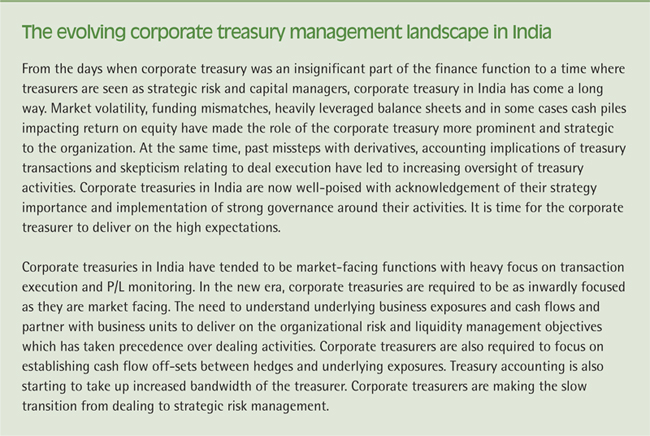
- Muzammil Patel
- Partner, Deloitte Touche Tohmatsu India LLP
by Muzammil Patel, Senior Director, Enterprise Risk Services, Deloitte Tohmatsu India Pvt. Ltd
1. Executive summary
Corporate treasury has evolved into a truly strategic function for most organizations. From being a manager of liquidity and financial risk, corporate treasury has evolved into a strategic business partner. As this transition of corporate treasury into a strategic function continues, different organizations are at varying stages of evolution. Organizations are also seeking to establish the right construct of the treasury function to enable them to meet the heightened expectations. Deloitte Touche Tohmatsu India Private Limited (‘DTTIPL’) conducted a survey of 63 Indian corporate treasurers to seek views on the following aspects:
- The role envisaged for the treasury function and addressing challenges in meeting expectations
- How treasuries are gearing to support long-term enterprise growth
- Changing landscape of financial risk management
- Managing the global nature of cash flows and role of treasury in supporting these flows
- Addressing business surpluses and their impact on return on equity

Survey demographics
Responses to the Corporate Treasury Survey were received from 63 leading companies in India. The respondent profile covered Chief Financial Officers and Corporate Treasurers. The survey covered a wide array of industries excluding financial services. The industry-wise classification of respondents was as follows: Manufacturing, 46%; Energy & Resources, 22%; Technology, Media & Telecommunications, 16%; Consumer Business, 11%; Life Sciences & Health Care, 5%.[[[PAGE]]]
2. Emerging role of the corporate treasury function

Managing cash flow risk and P/L volatility has traditionally been the focus area of the corporate treasury function. More than 86% of the respondents confirmed that their treasury function has currently been tasked with this aspect. 78% of the respondents believe that managing financial risk will continue to be among their Top 3 priorities. The role of treasury as a financial risk manager appears cemented and is unlikely to change in the near future.
More than 70% of the respondents considered funding long-term growth, financing working capital and optimizing return of surplus as core to their treasury function. However, a number of respondents perceive that the role of corporate treasury will expand into new areas including acting as an advisor to business units and managing credit relations. There is a strong belief that earning revenue should not be a treasury focus area with only 11% of the respondents placing it as a top 3 priority.
As corporate treasurers gear towards meeting the heightened expectations, there are certain internal and external challenges that still persist. Corporate treasurers generally attribute their internal challenges in treasury management to lack of clear view on exposures and inadequate control over working capital utilization. More than 48% of the respondents considered lack of clear view on exposures as the single largest internal challenge. In terms of external challenges, treasurers rated lack of quality talent in the market-place and laws affecting cash pooling as the largest deterrents.

Click image to enlarge
In terms of the role of the regulator, nearly 57% of the respondents believed that Reserve Bank of India regulations are either optimal or constraining but necessary in the given environment. Further, more than half of the respondents continued to rank unmanageable volatility in financial markets as their largest worry.[[[PAGE]]]
Most corporate treasurers believe that investment in processes and robust treasury frameworks are critical for meeting heightened expectations. In this regard, corporate treasurers believe that the most critical enablers will be automation of treasury processes and implementation of treasury performance management systems. Corporate treasurers also believe that their largest near-term investment in strengthening the treasury function will be in the areas of automation of treasury and trade finance operations and development of decision support tools and risk models.

Click image to enlarge
3. Gearing towards supporting long-term enterprise growth
Corporate treasuries have traditionally been focused on raising long-term funds for financing projects. However, as businesses evolve, treasurers see an increasing role in optimizing leverage thereby enhancing return on equity, managing investor relations and raising equity capital. While more than 67% of treasurers continue to believe that aligning business cash flows with debt servicing obligations is critical for supporting long-term growth, 65% also believe that optimizing leverage and enhancing return on equity is critical for supporting long-term growth. External commercial borrowings continue to be the instrument of choice for funding long-term growth.
4. Changing landscape of financial risk management
[[[PAGE]]]


Click image to enlarge
The role of Board and senior management in overseeing hedging programs has increased. More than 56% of the respondents operated on a mandate based hedging program with specific instructions from the Risk Committee or Board. Only 6% of the respondents had an opportunistic program based on market movements. The need for a structured hedging program was clear among respondents with only 11% indicating that they had no hedging program in place.
The role of the Board in overseeing and reviewing the financial risk management program is more pronounced than before. Most of the focus of treasurers is on optimizing existing hedging programs and partnering more closely with business on exposure identification.
5. Managing the global nature of cash flows
With increasing global presence, the role of corporate treasury in cross border activities has increased. However, less than 11% expressed their desire to set up a global treasury outside India. Treasurers reported that lack of adequate information from business units continued to be their biggest challenge in managing global cash flows. They also blamed forex and commodity price variability as reasons for difficulties in cash flow management.
Nearly 70% of the respondents believed that reducing working capital utilization through stronger monitoring is one of their Top 2 priorities. More than 83% of the respondents believe that investment in technology and reporting systems will prove to be a key differentiator in effective working capital utilization and monitoring.[[[PAGE]]]
6. Addressing business surpluses and their impact on return on equity
Treasurers responded that improving monitoring over idle cash and pooling cash across entities are their most important priorities for enhancing returns of surpluses. 73% of treasurers responded that tax planning was an integral part of their cash pooling and deployment strategy. Treasurers were divided on whether dividend payment and share buyback are in integral part of the decision on cash deployment horizon.
7. Building the corporate treasury of the future

Click image to enlarge
The corporate treasury of the future is expected to have a more strategic role in an organization’s growth story. While the corporate treasurer embraces the strategic role, managing financial risk and maintaining control over liquidity will continue to become important. Corporate treasuries will also see an increase in transaction volumes leading to strain on operational resources. The corporate treasury of the future will most likely operate in a three tiered structure addressing different facets of shareholder and management expectations from the corporate treasurer. The architecture of the Indian corporate treasury of the future is depicted in Figure 7.1.
As a corporate treasurer takes on both a more strategic and expanded role, there are multiple challenges that need to be overcome. These include limited availability of quality talent; reliance on disparate and sometimes unavailable information for decision making and ensuring that operational risk is closely monitored and controlled. The corporate treasurer is also expected to become an advisor to business assisting them in structuring contracts to mitigate financial risk and advising them on potential economic risks that can impact the business value chain.
Given the heightened expectations from the corporate treasurer, certain aspects become critical in meeting and managing expectations:
- Leveraging technology to provide accurate and timely business information and for straight through processing of transactions
- Putting in place decision support and risk quantification tools
- Clear and measurable treasury performance metrics at each tier of the treasury structure and the ability to continuously monitor the metrics
- Mechanizing processes and operations and upskilling people to ensure that a higher proportion of bandwidth can be assigned to the shareholders’ treasury















